The global propylmagnesium chloride market is projected to grow from USD 208.1 million in 2025 to USD 308.1 million by 2035, advancing at a CAGR of 4%. The propylmagnesium chloride industry stands at the threshold of a decade-long expansion trajectory that promises to reshape organometallic reagent manufacturing and pharmaceutical intermediate production technology. The market's journey from USD 208.1 million in 2025 to USD 308.1 million by 2035 represents substantial growth, demonstrating the accelerating adoption of advanced Grignard reagent systems and specialized organometallic compounds across pharmaceutical manufacturing, chemical synthesis facilities, and advanced organic chemistry applications worldwide.
The first half of the decade (2025-2030) will witness the market climbing from USD 208.1 million to approximately USD 253.2 million, adding USD 45.1 million in value, which constitutes 45% of the total forecast growth period. This phase will be characterized by the rapid adoption of high-purity propylmagnesium chloride systems, driven by increasing pharmaceutical demand and modernization programs in chemical synthesis worldwide. Advanced purity specifications and specialized handling features will become standard expectations rather than premium options.
The latter half (2030-2035) will witness sustained growth from USD 253.2 million to USD 308.1 million, representing an addition of USD 54.9 million or 55% of the decade's expansion. This period will be defined by mass market penetration of next-generation organometallic reagents, integration with comprehensive pharmaceutical manufacturing platforms, and seamless compatibility with existing chemical synthesis infrastructure. The market trajectory signals fundamental shifts in how pharmaceutical manufacturers approach organometallic chemistry and intermediate synthesis, with participants positioned to benefit from sustained demand across multiple application segments.
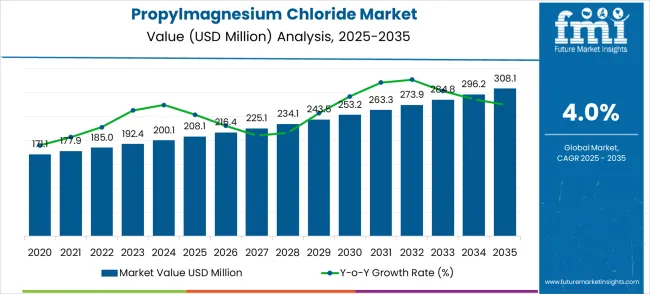
The Propylmagnesium Chloride market demonstrates distinct growth phases with varying market characteristics and competitive dynamics. Between 2025 and 2030, the market progresses through its pharmaceutical adoption phase, expanding from USD 208.1 million to USD 253.2 million with steady annual increments averaging 4.0% growth. This period showcases the transition from basic organometallic reagent systems to advanced high-purity platforms with enhanced reactivity capabilities and integrated quality control systems becoming mainstream features.
The 2025-2030 phase adds USD 45.1 million to market value, representing 45% of total decade expansion. Market maturation factors include standardization of purity protocols, declining production costs for high-grade organometallic systems, and increasing pharmaceutical manufacturer awareness of specialized Grignard reagent benefits reaching 85-90% efficiency improvements in synthetic chemistry applications. Competitive landscape evolution during this period features established chemical manufacturers like Albemarle Corporation and Merck expanding their organometallic reagent portfolios while new entrants focus on specialized formulations and enhanced purity capabilities.
From 2030 to 2035, market dynamics shift toward advanced integration and multi-platform deployment, with growth accelerating from USD 253.2 million to USD 308.1 million, adding USD 54.9 million or 55% of total expansion. This phase transition logic centers on next-generation organometallic systems, integration with Industry 4.0 chemical manufacturing networks, and deployment across diverse pharmaceutical synthesis scenarios, becoming standard rather than specialized applications. The competitive environment matures with focus shifting from basic reagent capability to comprehensive organometallic chemistry systems and integration with facility-wide synthesis automation and process control platforms.
| Metric | Value |
|---|---|
| $ Market Value (2025) → | USD 208.1 million |
| $ Market Forecast (2035) ↑ | USD 308.1 million |
| # Growth Rate ★ | 4.0% CAGR |
| Leading Technology → | I-Propylmagnesium Chloride |
| Primary Application → | Organic Synthesis |
The market demonstrates strong fundamentals with I-propylmagnesium chloride systems capturing a dominant 64.2% share through advanced reactivity properties and high-purity synthesis capabilities. Organic synthesis applications drive primary demand with 58.7% market share, supported by increasing pharmaceutical manufacturing and advanced chemical synthesis requirements. Geographic expansion remains concentrated in developed markets with established pharmaceutical infrastructure, while emerging economies show accelerating adoption rates driven by generic drug production and rising chemical manufacturing investments.
Market expansion rests on three fundamental shifts driving adoption across pharmaceutical and chemical manufacturing sectors.
1. Advanced synthesis demand creates compelling operational advantages through propylmagnesium chloride systems that provide precise organometallic reactivity with consistent product formation, enabling manufacturers to achieve higher yields while maintaining purity standards and reducing synthetic complexity risks.
2. Pharmaceutical manufacturing modernization accelerates as drug development facilities worldwide seek specialized reagent systems that complement existing synthesis processes, enabling efficient organometallic chemistry and intermediate formation applications that align with regulatory requirements and quality control protocols.
3. Chemical industry infrastructure enhancement drives adoption from pharmaceutical companies and chemical manufacturers requiring effective organometallic solutions that maximize synthetic efficiency while maintaining product quality during complex drug synthesis and chemical intermediate production operations.
However, growth faces headwinds from handling complexity challenges that vary across different synthesis applications and regulatory requirements, which may limit operational flexibility in certain manufacturing environments. Cost considerations also persist regarding specialized storage and handling expenses that may reduce system adoption rates in price-sensitive market segments that prioritize immediate cost savings over long-term synthesis benefits.
The propylmagnesium chloride market presents significant growth opportunities as global pharmaceutical manufacturing paradigms shift toward specialized organometallic reagent solutions and advanced synthesis chemistry accelerates worldwide. With the market projected to expand from USD 208.1 million in 2025 to USD 308.1 million by 2035 at a 4.0% CAGR, chemical manufacturers and pharmaceutical suppliers are positioned to capitalize on structural demand from drug manufacturing facilities, chemical synthesis companies, and research institutions requiring precise organometallic chemistry and intermediate synthesis capabilities.
The convergence of pharmaceutical industry modernization programs, increasing drug complexity requirements, and specialization emphasis on advanced synthetic chemistry creates sustained market expansion opportunities. Geographic growth differentials are particularly pronounced in China (5.4% CAGR) and India (5.0% CAGR), where rapid pharmaceutical development and chemical manufacturing infrastructure investments drive substantial demand. Technology advancement pathways around purity enhancement, reactivity optimization, and process integration offer differentiation opportunities, while specialized applications across drug synthesis, high molecular chemistry, and research facilities provide diverse revenue streams.
I-propylmagnesium chloride dominance and organic synthesis application leadership indicate established foundations for strategic expansion, while drug intermediate applications represent emerging growth vectors. Global pharmaceutical investments support sustained procurement, while advanced synthesis and specialty chemistry requirements drive operational deployment.
Growth Accelerators: Pharmaceutical industry modernization drives primary adoption as propylmagnesium chloride systems provide specialized organometallic reactivity that enables consistent drug intermediate synthesis with precise stoichiometry, supporting complex pharmaceutical manufacturing that requires exact chemical transformations. Advanced synthesis chemistry demand accelerates market expansion as pharmaceutical facilities seek efficient Grignard reagent tools that minimize reaction complexity while maintaining product purity and yield optimization during critical synthetic transformations and API production processes. Chemical manufacturing industry growth creates sustained demand for organometallic reagents that complement advanced synthesis systems and provide operational flexibility in complex pharmaceutical environments where precision and reproducibility represent critical manufacturing requirements.
Generic drug production trends further amplify adoption as manufacturers implement cost-effective synthesis concepts requiring specialized reagents with proven reactivity capabilities, real-time quality monitoring, and integration with pharmaceutical manufacturing systems that optimize production workflow and enable regulatory compliance verification. Complex pharmaceutical development requirements drive specialized organometallic reagent demand as drug manufacturers adopt new synthetic methodologies including asymmetric synthesis, cascade reactions, and integrated synthetic approaches that necessitate precise chemical control and specialized reagent capabilities beyond traditional applications.
High molecular chemistry market expansion, particularly in polymer and specialty chemical synthesis, creates specialized organometallic requirements due to unique reactivity properties and synthesis challenges that demand customized reagent solutions with enhanced purity control and contamination prevention features. Research and development activity acceleration in pharmaceutical chemistry drives demand for flexible reagent systems capable of supporting diverse synthetic methodologies and experimental synthesis requirements that support next-generation drug development and advanced chemical research applications.
Growth Inhibitors: Handling safety barriers persist as propylmagnesium chloride systems require specialized storage conditions and safety protocols ranging from inert atmosphere maintenance to moisture exclusion procedures, which may limit adoption among smaller pharmaceutical manufacturers and research facilities operating under constrained safety infrastructure or uncertain regulatory compliance scenarios. Technical complexity challenges create integration difficulties when incorporating organometallic reagents into existing synthesis infrastructure, particularly in older facilities where legacy equipment compatibility and process modification requirements can result in extended implementation timelines and additional safety engineering costs.
Regulatory compliance limitations affect market penetration as specialized organometallic reagents including pharmaceutical-grade materials, research chemicals, and experimental compounds may require extensive documentation and certification that increase procurement costs and reduce supply chain flexibility. Market fragmentation across diverse pharmaceutical applications creates compatibility concerns between different reagent suppliers and existing synthesis equipment, potentially limiting supplier selection and increasing procurement complexity for pharmaceutical operators managing multiple chemical vendor relationships.
Supply chain vulnerabilities in specialized organometallic compounds and high-purity reagent systems can impact delivery schedules and product availability, particularly during periods of high pharmaceutical manufacturing demand when raw material shortages and extended lead times affect customer synthesis programs and facility production timelines.
Market Evolution Patterns: Technology adoption accelerates in advanced pharmaceutical manufacturing facilities where synthesis precision justifies reagent costs, with geographic concentration in major pharmaceutical regions transitioning toward mainstream adoption in emerging manufacturing hubs driven by generic drug production growth and chemical facility development programs. Reagent sophistication increases as organometallic systems incorporate advanced purification techniques, stabilization technologies, and enhanced packaging methods that improve storage stability and enable adaptive synthesis capabilities for diverse pharmaceutical manufacturing requirements.
Market consolidation trends emerge as larger chemical manufacturers acquire specialized organometallic companies to expand reagent portfolios and provide comprehensive synthesis solutions that address complete pharmaceutical manufacturing workflows. The market could face disruption if alternative organometallic technologies or revolutionary synthetic approaches significantly change pharmaceutical manufacturing processes or eliminate traditional Grignard reagent requirements in advanced drug production environments.
Primary Market Structure: The market segments by isomer type into I-Propylmagnesium Chloride and N-Propylmagnesium Chloride categories, representing the evolution from conventional organometallic reagents to specialized isomer-specific platforms for enhanced reactivity and selective synthetic applications.
Secondary Breakdown: Application segmentation divides the market into organic synthesis, high molecular chemistry, drug intermediate production, and others, reflecting distinct requirements for pharmaceutical synthesis, polymer chemistry, and specialty organometallic manufacturing applications.
Regional Distribution: Geographic classification covers Asia Pacific, North America, Europe, Latin America, and the Middle East & Africa, with established pharmaceutical manufacturing regions leading adoption while emerging economies show accelerating growth patterns driven by generic drug production and chemical manufacturing development programs.
The segmentation structure reveals technology progression from basic organometallic reagents toward specialized isomer-specific platforms with enhanced selectivity and purity capabilities, while application diversity spans from traditional organic synthesis to emerging high molecular chemistry requiring specialized organometallic solutions for advanced chemical transformations.
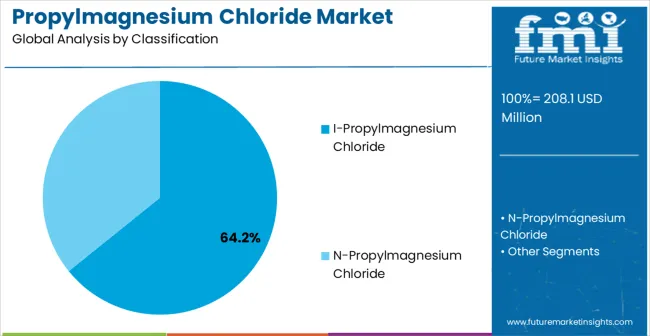
Market Position: I-propylmagnesium chloride systems command the leading position in the Propylmagnesium Chloride market with 64.2% market share through advanced reactivity features, including selective carbon-carbon bond formation, controlled organometallic chemistry, and integrated purity monitoring that enable pharmaceutical manufacturers to achieve consistent synthesis quality across high-volume production operations.
Value Drivers: The segment benefits from pharmaceutical industry preference for I-propylmagnesium chloride that provides superior selectivity and reaction control without requiring extensive purification procedures for each synthesis cycle. Advanced isomer design features enable deployment in regulated pharmaceutical environments, continuous synthesis operations, and 24/7 manufacturing facilities where consistency and reproducibility represent critical operational requirements for API production and drug intermediate synthesis applications.
Competitive Advantages: I-propylmagnesium chloride systems differentiate through selective reaction mechanisms, controlled organometallic transformations, and integration with pharmaceutical synthesis networks that enhance production efficiency while maintaining quality standards suitable for pharmaceutical specifications and regulatory compliance requirements.
Key market characteristics:
The N-propylmagnesium chloride segment maintains 35.8% market share, primarily serving specialty synthesis applications, research requirements, and specialized organometallic chemistry where operational flexibility and alternative reactivity outweigh selectivity benefits in specific manufacturing scenarios.
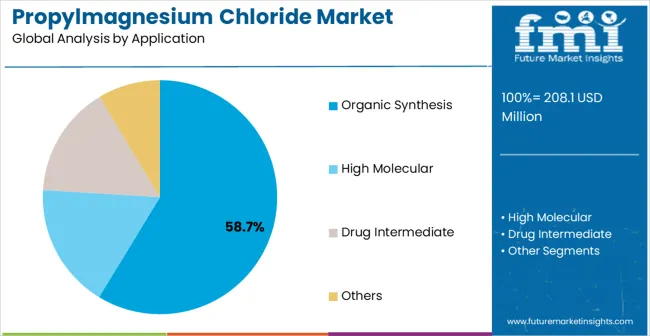
Market Context: Organic synthesis applications dominate the Propylmagnesium Chloride market with 58.7% market share due to widespread pharmaceutical manufacturing and increasing focus on complex drug development, API production, and organometallic chemistry applications that require precise reagent control for maintaining synthesis efficiency and pharmaceutical quality optimization.
Appeal Factors: Organic synthesis customers prioritize reaction selectivity, yield optimization, and integration with existing pharmaceutical manufacturing equipment that enables coordinated synthesis across multiple production stages. The segment benefits from substantial pharmaceutical industry investments and drug development programs that emphasize specialized organometallic solutions for conventional synthetic chemistry in pharmaceutical, fine chemical, and specialty manufacturing applications.
Growth Drivers: Pharmaceutical industry expansion incorporates propylmagnesium chloride as essential reagents for complex synthesis and API production operations, while increasing drug complexity and regulatory requirements drive demand for precise organometallic capabilities that maintain pharmaceutical specifications and manufacturing quality standards. Advanced pharmaceutical synthesis trends, including asymmetric synthesis and cascade reactions, create additional reagent requirements for specialized organometallic chemistry and pharmaceutical intermediate preparation processes.
Market Challenges: Synthesis complexity and diverse pharmaceutical specifications may require customized reagent solutions that increase system costs and reduce standardization benefits across different pharmaceutical manufacturing applications and synthesis requirements.
Application dynamics include:
The High Molecular Chemistry segment holds 18.6% market share, representing growing opportunities in polymer synthesis for specialty chemicals, advanced materials, and high-performance chemical production where unique organometallic properties require specialized reagent solutions and chemistry protocols.
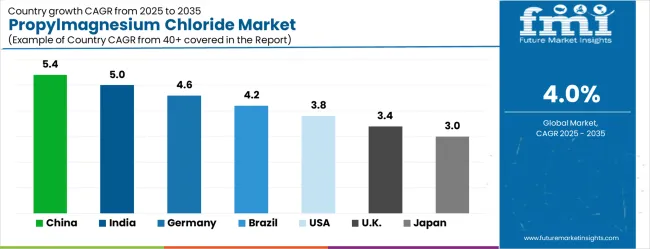
The Propylmagnesium Chloride market demonstrates varied regional dynamics with Growth Leaders including China (5.4% CAGR) and India (5.0% CAGR) driving expansion through pharmaceutical manufacturing development and chemical synthesis infrastructure growth. Steady Performers encompass Germany (4.6% CAGR), Brazil (4.2% CAGR), and the USA (3.8% CAGR), benefiting from established pharmaceutical industries and advanced organometallic chemistry adoption. Mature Markets feature the UK (3.4% CAGR) and Japan (3.0% CAGR), where specialized pharmaceutical applications and synthesis chemistry integration support consistent growth patterns.
| Country | CAGR (2025-2035) |
|---|---|
| China | 5.4% |
| India | 5.0% |
| Germany | 4.6% |
| Brazil | 4.2% |
| USA | 3.8% |
| UK | 3.4% |
| Japan | 3.0% |
Regional synthesis reveals Asia-Pacific markets leading growth through pharmaceutical manufacturing expansion and chemical synthesis infrastructure development, while European countries maintain steady expansion supported by advanced pharmaceutical technology and research facility investments. North American markets show moderate growth driven by pharmaceutical innovation and specialty chemistry applications.
The report covers an in-depth analysis of 40+ countries top-performing countries are highlighted below.
China establishes market leadership through aggressive pharmaceutical manufacturing development programs and comprehensive chemical synthesis infrastructure expansion, integrating advanced propylmagnesium chloride systems as standard components in drug manufacturing automation and efficient organometallic chemistry applications.
The country's 5.4% CAGR through 2035 reflects government initiatives promoting domestic pharmaceutical capability and chemical manufacturing competitiveness that mandate specialized reagent systems in production facilities and research installations. Growth concentrates in major pharmaceutical clusters, including Jiangsu, Shanghai, and Beijing, where technology development showcases integrated organometallic chemistry systems that appeal to domestic manufacturers seeking automated synthesis capabilities and pharmaceutical applications.
Chinese manufacturers are developing cost-effective propylmagnesium chloride solutions that combine domestic production advantages with advanced purity features, including quality control systems and integrated pharmaceutical compatibility capabilities. Distribution channels through state pharmaceutical programs and chemical synthesis equipment suppliers expand market access, while government funding for pharmaceutical technology development supports adoption across diverse manufacturing and research segments.
Strategic Market Indicators:
In Mumbai, Hyderabad, and Pune, pharmaceutical facilities and chemical manufacturers are implementing advanced propylmagnesium chloride systems as standard reagents for organometallic synthesis operations and drug intermediate production applications, driven by increasing generic drug manufacturing and government programs that emphasize pharmaceutical competitiveness and quality capabilities.
The market is projected to demonstrate a 5.0% CAGR through 2035, supported by government pharmaceutical initiatives and chemical manufacturing development programs that promote specialized reagent systems for domestic facilities and export manufacturing projects. Indian pharmaceutical companies are adopting propylmagnesium chloride systems that provide efficient synthesis capabilities and quality assurance features, particularly appealing in pharmaceutical regions where precision chemistry represents critical operational requirements for export competitiveness.
Market expansion benefits from growing pharmaceutical manufacturing capabilities and international technology partnerships that enable domestic production of advanced organometallic systems for pharmaceutical and chemical synthesis applications. Technology adoption follows patterns established in pharmaceutical automation, where quality control and reliability drive procurement decisions and operational deployment strategies.
Market Intelligence Brief:
Germany's advanced pharmaceutical technology market demonstrates sophisticated propylmagnesium chloride deployment with documented operational effectiveness in pharmaceutical research facilities and chemical synthesis applications through integration with existing automation systems and quality control infrastructure.
The country leverages engineering expertise in pharmaceutical chemistry and organometallic systems integration to maintain a 4.6% CAGR through 2035. Technology centers, including Frankfurt, Munich, and Hamburg, showcase premium installations where propylmagnesium chloride integrates with comprehensive synthesis platforms and pharmaceutical manufacturing equipment to optimize organometallic effectiveness and quality compliance capabilities.
German chemical manufacturers prioritize reagent purity and pharmaceutical compatibility in propylmagnesium chloride development, creating demand for premium systems with advanced features, including environmental control and integration with pharmaceutical facility infrastructure. The market benefits from established pharmaceutical leadership and willingness to invest in advanced organometallic technologies that provide long-term operational benefits and support pharmaceutical excellence requirements.
Market Intelligence Brief:
Brazil's market expansion benefits from diverse pharmaceutical manufacturing demand, including generic drug production in São Paulo and Rio de Janeiro, chemical synthesis equipment upgrades, and government pharmaceutical programs that increasingly incorporate specialized organometallic solutions for manufacturing competitiveness applications. The country maintains a 4.2% CAGR through 2035, driven by rising pharmaceutical production and increasing awareness of propylmagnesium chloride technology benefits, including automated synthesis and quality improvement capabilities for domestic manufacturing operations.
Market dynamics focus on cost-effective propylmagnesium chloride solutions that balance advanced organometallic features with affordability considerations important to Brazilian pharmaceutical and chemical manufacturers. Growing pharmaceutical sector development creates sustained demand for efficient reagent systems in manufacturing infrastructure and research facility modernization projects.
Strategic Market Considerations:
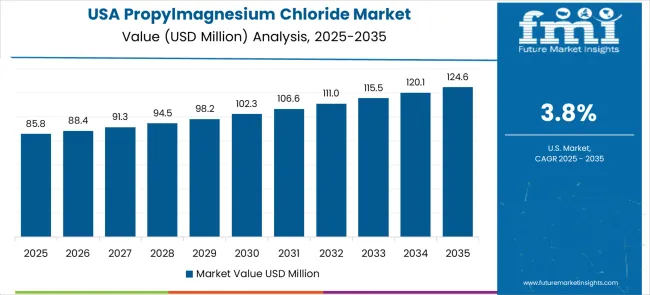
The USA market emphasizes advanced propylmagnesium chloride features, including automated reagent systems and integration with comprehensive pharmaceutical manufacturing platforms that manage organometallic chemistry, process control, and quality assurance applications through unified automation systems.
The country is projected to show a 3.8% CAGR through 2035, driven by pharmaceutical industry modernization under chemical manufacturing equipment upgrades and facility demand for reliable automated organometallic systems with advanced purity capabilities. American pharmaceutical manufacturers prioritize operational effectiveness with propylmagnesium chloride delivering consistent synthesis results through advanced quality control algorithms and environmental adaptation capabilities for diverse pharmaceutical requirements.
Technology deployment channels include major pharmaceutical equipment suppliers, specialized chemical system providers, and research facility procurement programs that support professional installation for complex manufacturing applications. Pharmaceutical industry integration capabilities with established synthesis systems expand market appeal across diverse operational requirements seeking precision and reliability benefits in advanced drug production environments.
Performance Metrics:
In Cambridge, Oxford, and other pharmaceutical research centers, British pharmaceutical facilities and chemical manufacturers are implementing advanced propylmagnesium chloride systems to enhance organometallic capabilities and support drug development that aligns with pharmaceutical research requirements and synthesis protocols.
The UK market demonstrates sustained growth with a 3.4% CAGR through 2035, driven by research facility modernization programs and pharmaceutical development initiatives that emphasize advanced organometallic reagents for drug discovery and specialty pharmaceutical manufacturing applications. British pharmaceutical institutions prioritize propylmagnesium chloride systems that provide precise organometallic reactivity while maintaining compatibility with existing research equipment and enabling diverse synthesis requirements, particularly important in drug discovery research and pharmaceutical development projects.
Market expansion benefits from government pharmaceutical research funding programs that mandate advanced organometallic capabilities in research equipment specifications, creating sustained demand across the UK's pharmaceutical research sectors where operational precision and chemical compatibility represent critical requirements. The regulatory framework supports propylmagnesium chloride adoption through research facility standards and pharmaceutical collaboration requirements that promote advanced organometallic systems aligned with global pharmaceutical research capabilities.
Strategic Market Indicators:
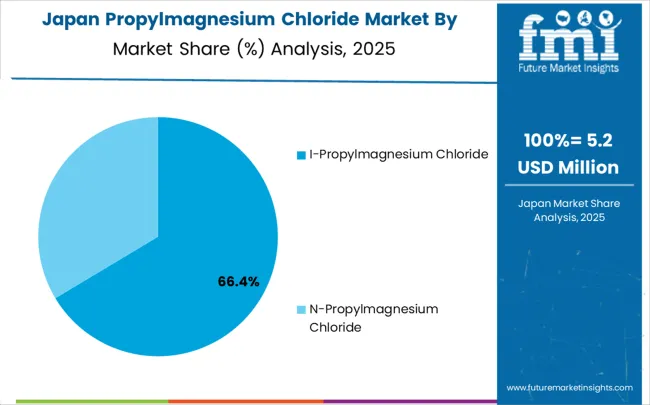
Japan demonstrates steady market development with a 3.0% CAGR through 2035, distinguished by pharmaceutical manufacturers' preference for high-precision propylmagnesium chloride that integrates seamlessly with existing synthesis systems and provides reliable long-term operation in specialized pharmaceutical applications. The market prioritizes advanced features, including precision control, quality monitoring, and integration with comprehensive pharmaceutical platforms that reflect Japanese manufacturing expectations for technological sophistication and operational excellence in pharmaceutical environments.
Market Intelligence Brief:
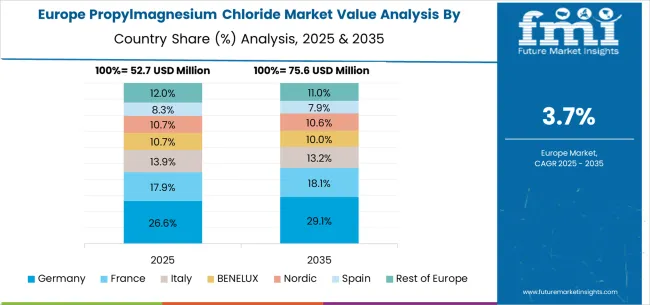
The European Propylmagnesium Chloride market is projected to grow from USD 52.4 million in 2025 to USD 68.9 million by 2035, registering a CAGR of 2.8% over the forecast period. Germany is expected to maintain its leadership position with a 36.7% market share in 2025, declining slightly to 36.2% by 2035, supported by its advanced pharmaceutical manufacturing infrastructure and major chemical research centers, including Frankfurt and Munich pharmaceutical clusters.
France follows with a 24.1% share in 2025, projected to reach 24.4% by 2035, driven by comprehensive pharmaceutical development programs and organometallic chemistry research initiatives. The United Kingdom holds a 17.3% share in 2025, expected to maintain 17.1% by 2035 through specialized pharmaceutical research applications and drug development programs. Italy commands a 10.5% share, while Spain accounts for 7.2% in 2025. The Rest of Europe region is anticipated to gain momentum, expanding its collective share from 4.2% to 4.6% by 2035, attributed to increasing propylmagnesium chloride adoption in Nordic countries and emerging Eastern European pharmaceutical facilities implementing manufacturing modernization programs.
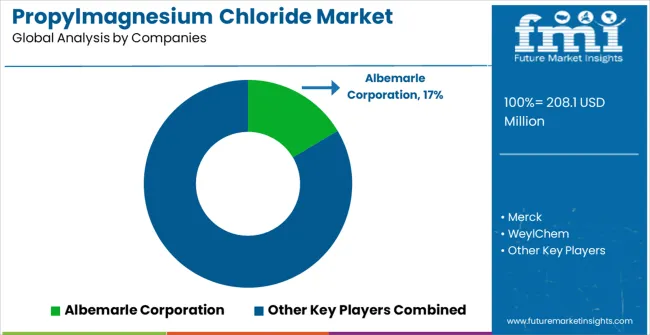
The propylmagnesium chloride market operates with moderate concentration, featuring approximately 10-15 meaningful participants, where leading companies control roughly 45-50% of the global market share through established pharmaceutical and chemical industry relationships and comprehensive reagent portfolios. Competition emphasizes purity specifications, supply reliability, and pharmaceutical compatibility rather than price-based rivalry in the specialty reagent segment.
Market Leaders encompass Albemarle Corporation, Merck, and WeylChem, which maintain competitive advantages through extensive pharmaceutical industry expertise, global chemical supplier networks, and comprehensive quality assurance capabilities that create customer switching costs and support premium positioning. These companies leverage decades of organometallic chemistry experience and ongoing research investments to develop advanced propylmagnesium chloride systems with pharmaceutical-grade purity and regulatory compliance features.
Technology Innovators include Thermo Fisher Scientific and TCI Chemicals, which compete through specialized organometallic chemistry focus and innovative purity interfaces that appeal to pharmaceutical customers seeking advanced quality capabilities and synthesis flexibility. These companies differentiate through rapid product development cycles and specialized pharmaceutical application expertise focused on next-generation synthesis requirements.
Regional Specialists feature companies that focus on specific geographic markets and specialized applications, including research reagents and custom synthesis solutions. Market dynamics favor participants that combine reliable supply chains with advanced quality control systems, including purity verification and regulatory compliance capabilities. Competitive pressure intensifies as traditional chemical manufacturers expand into specialized organometallic systems, while pharmaceutical reagent companies challenge established players through innovative purity solutions and cost-effective platforms targeting emerging pharmaceutical manufacturing segments.
| Item | Value |
|---|---|
| Quantitative Units | USD 208.1 million |
| Isomer Type | I-Propylmagnesium Chloride, N-Propylmagnesium Chloride |
| Application | Organic Synthesis, High Molecular Chemistry, Drug Intermediate, Others |
| Regions Covered | Asia Pacific, North America, Europe, Latin America, Middle East & Africa |
| Countries Covered | China, India, Germany, Brazil, the U.S., the U.K., Japan, and 25+ additional countries |
| Key Companies Profiled | Albemarle Corporation, Merck, WeylChem, Thermo Fisher Scientific, TCI Chemicals |
| Additional Attributes | Dollar sales by isomer type and application categories, regional adoption trends across Asia Pacific, North America, and Europe, competitive landscape with pharmaceutical chemical manufacturers and reagent providers, customer preferences for purity standards and supply reliability, integration with synthesis platforms and quality control systems, innovations in purification methods and handling protocols, and development of specialized solutions with enhanced purity and pharmaceutical compliance capabilities. |
The global propylmagnesium chloride market is estimated to be valued at USD 208.1 million in 2025.
The market size for the propylmagnesium chloride market is projected to reach USD 308.1 million by 2035.
The propylmagnesium chloride market is expected to grow at a 4.0% CAGR between 2025 and 2035.
The key product types in propylmagnesium chloride market are i-propylmagnesium chloride and n-propylmagnesium chloride.
In terms of application, organic synthesis segment to command 58.7% share in the propylmagnesium chloride market in 2025.






Our Research Products

The "Full Research Suite" delivers actionable market intel, deep dives on markets or technologies, so clients act faster, cut risk, and unlock growth.

The Leaderboard benchmarks and ranks top vendors, classifying them as Established Leaders, Leading Challengers, or Disruptors & Challengers.

Locates where complements amplify value and substitutes erode it, forecasting net impact by horizon

We deliver granular, decision-grade intel: market sizing, 5-year forecasts, pricing, adoption, usage, revenue, and operational KPIs—plus competitor tracking, regulation, and value chains—across 60 countries broadly.

Spot the shifts before they hit your P&L. We track inflection points, adoption curves, pricing moves, and ecosystem plays to show where demand is heading, why it is changing, and what to do next across high-growth markets and disruptive tech

Real-time reads of user behavior. We track shifting priorities, perceptions of today’s and next-gen services, and provider experience, then pace how fast tech moves from trial to adoption, blending buyer, consumer, and channel inputs with social signals (#WhySwitch, #UX).

Partner with our analyst team to build a custom report designed around your business priorities. From analysing market trends to assessing competitors or crafting bespoke datasets, we tailor insights to your needs.
Supplier Intelligence
Discovery & Profiling
Capacity & Footprint
Performance & Risk
Compliance & Governance
Commercial Readiness
Who Supplies Whom
Scorecards & Shortlists
Playbooks & Docs
Category Intelligence
Definition & Scope
Demand & Use Cases
Cost Drivers
Market Structure
Supply Chain Map
Trade & Policy
Operating Norms
Deliverables
Buyer Intelligence
Account Basics
Spend & Scope
Procurement Model
Vendor Requirements
Terms & Policies
Entry Strategy
Pain Points & Triggers
Outputs
Pricing Analysis
Benchmarks
Trends
Should-Cost
Indexation
Landed Cost
Commercial Terms
Deliverables
Brand Analysis
Positioning & Value Prop
Share & Presence
Customer Evidence
Go-to-Market
Digital & Reputation
Compliance & Trust
KPIs & Gaps
Outputs
Full Research Suite comprises of:
Market outlook & trends analysis
Interviews & case studies
Strategic recommendations
Vendor profiles & capabilities analysis
5-year forecasts
8 regions and 60+ country-level data splits
Market segment data splits
12 months of continuous data updates
DELIVERED AS:
PDF EXCEL ONLINE
Zinc Chloride Market Analysis - Size, Share, and Forecast 2025 to 2035
Acid Chlorides Market Size and Share Forecast Outlook 2025 to 2035
Allyl Chloride Market Size and Share Forecast Outlook 2025 to 2035
Barium Chloride Market Size and Share Forecast Outlook 2025 to 2035
Sodium Chloride Market Size and Share Forecast Outlook 2025 to 2035
Ferric Chloride Market Size and Share Forecast Outlook 2025 to 2035
Industry Share Analysis for Cupric Chloride Companies
Calcium Chloride Market Size and Share Forecast Outlook 2025 to 2035
Choline Chloride Market Size and Share Forecast Outlook 2025 to 2035
Thionyl Chloride Market Size and Share Forecast Outlook 2025 to 2035
Valeryl Chloride Market Size and Share Forecast Outlook 2025 to 2035
Aluminum Chloride Hexahydrate Market Size and Share Forecast Outlook 2025 to 2035
Pivaloyl Chloride Market Size and Share Forecast Outlook 2025 to 2035
Ammonium Chloride Food Grade Market Growth - Demand & Trends 2025 to 2035
Cyanuric Chloride Market
Polyvinyl Chloride (PVC) Packaging Film Market Forecast and Outlook 2025 to 2035
Magnesium Chloride Market Size and Share Forecast Outlook 2025 to 2035
Copper Oxychloride Market Size and Share Forecast Outlook 2025 to 2035
Aluminium Chloride Market Analysis - Size, Share & Forecast 2025 to 2035
Potassium Chloride Market Growth - Trends & Forecast 2025 to 2035

Thank you!
You will receive an email from our Business Development Manager. Please be sure to check your SPAM/JUNK folder too.
Chat With
MaRIA